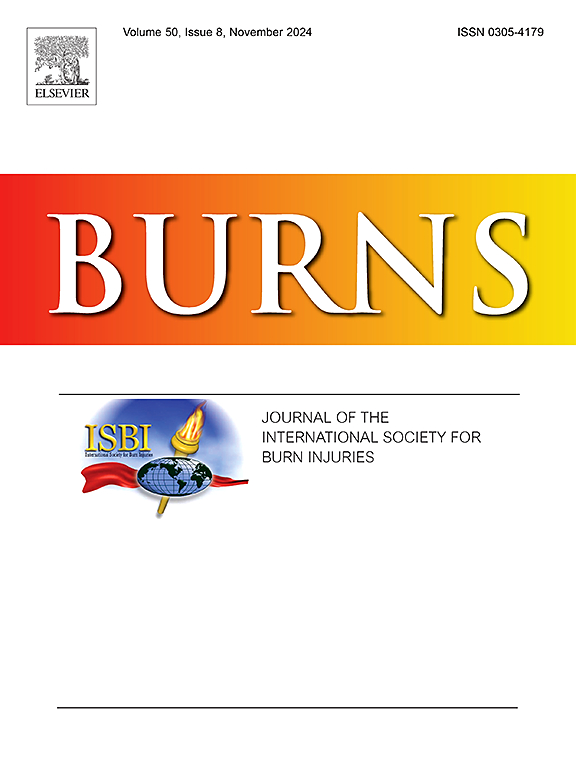Risk factors for antimicrobial resistance in paediatric burn infections: Insights from a retrospective cohort study
IF 2.9
3区 医学
Q2 CRITICAL CARE MEDICINE
引用次数: 0
Abstract
Aim
To define the microbiome, antimicrobial resistance profiles and associated risk factors among paediatric patients with infected burns.
Methods
A retrospective cohort study was conducted among paediatric patients with infected burns admitted to a tertiary burns service between January 2011 to December 2023. Basic demographic data and burn-related clinical information were extracted from the Burns Unit database and linked with microbiological data.
Result
Among a total of 3679 paediatric burn patients admitted, 183 (5 % of overall admitted) were identified as clinically having infected burns. Of the 173 (4.7 % of overall admitted) patients with documented cultures, 152 (87.9 % of suspected clinical infections) had culture-positive burn wound infections (BWIs) and 15 (8.7 % of overall admitted) had developed blood stream infections. The most common microorganisms identified in BWI were Gram-positive bacteria (245 isolates, 63.1 %), with Staphylococcus aureus being the most prevalent (32 %) followed by Streptococcus species (11.9 %). Gram-negative bacteria were identified in 32.5 % of cases, with Pseudomonas aeruginosa being the most common organism (5.7 %). Nineteen (5 %) methicillin-resistant Staphylococcus aureus isolates were detected from 17 (9.8 %) paediatric patients with burns. The highest resistance was reported against ampicillin (100 %) followed by penicillin (91.7 %), and amoxicillin (88.6 %) against S. aureus isolates. P. aeruginosa isolates showed resistance in 58.8 % of cases to ceftazidime, followed by 47 % to piperacillin-tazobactam, and 2 isolates were resistant to imipenem, a carbapenem antibiotic considered a last-resort option. Multivariate logistic regression analysis revealed that burns to the head and neck regions (AOR = 5.2, 95 %CI: 2.20–12.31; p < 0.001), admission to the paediatric intensive care unit (PICU) (AOR = 8.2, 95 %CI: 1.03–64.86; p = 0.047) and previous medical history (AOR = 2.4, 95 %CI: 1.07–5.55; p = 0.033) were independent risk factors associated with antimicrobial-resistant (AMR) burn infections
Conclusions
AMR in paediatric patients with infected burns is common and therefore early culture confirmation could improve treatment outcomes especially for patients with high risk factors.
儿童烧伤感染中抗菌素耐药性的危险因素:来自回顾性队列研究的见解
目的探讨小儿感染性烧伤患者的微生物组、抗菌素耐药性及相关危险因素。方法回顾性队列研究2011年1月至2023年12月住院的小儿感染性烧伤患者。基本的人口统计数据和烧伤相关的临床信息从烧伤科数据库中提取,并与微生物数据相关联。结果我院收治的3679例小儿烧伤患者中,临床诊断为感染性烧伤的有183例(占全部住院患者的5. %)。在173例(占总住院人数的4.7 %)记录培养的患者中,152例(占疑似临床感染人数的87.9% %)为培养阳性烧伤创面感染(BWIs), 15例(占总住院人数的8.7 %)发生血流感染。BWI中最常见的微生物是革兰氏阳性菌(245株,63.1 %),其中以金黄色葡萄球菌(32 %)最为常见,其次是链球菌(11.9 %)。革兰氏阴性菌占32.5% %,铜绿假单胞菌是最常见的菌(5.7% %)。从17例(9.8 %)烧伤患儿中检出耐甲氧西林金黄色葡萄球菌19株(5 %)。对金黄色葡萄球菌的耐药率最高的是氨苄西林(100 %),其次是青霉素(91.7 %)和阿莫西林(88.6% %)。铜绿假单胞菌对头孢他啶的耐药率为58.8% %,对哌拉西林-他唑巴坦的耐药率为47% %,对亚胺培南(一种被认为是最后选择的碳青霉烯类抗生素)的耐药率为2株。多因素logistic回归分析显示,头颈部烧伤(AOR = 5.2, 95 %CI: 2.20-12.31;p <; 0.001),儿科重症监护病房(PICU)入院(AOR = 8.2, 95 %CI: 1.03-64.86;p = 0.047)和既往病史(AOR = 2.4, 95 %CI: 1.07-5.55;p = 0.033)是与抗菌药物耐药(AMR)烧伤感染相关的独立危险因素。结论抗菌药物耐药(AMR)在小儿感染性烧伤患者中很常见,因此早期培养可改善治疗效果,特别是对高危因素患者。
本文章由计算机程序翻译,如有差异,请以英文原文为准。
求助全文
约1分钟内获得全文
求助全文
来源期刊

Burns
医学-皮肤病学
CiteScore
4.50
自引率
18.50%
发文量
304
审稿时长
72 days
期刊介绍:
Burns aims to foster the exchange of information among all engaged in preventing and treating the effects of burns. The journal focuses on clinical, scientific and social aspects of these injuries and covers the prevention of the injury, the epidemiology of such injuries and all aspects of treatment including development of new techniques and technologies and verification of existing ones. Regular features include clinical and scientific papers, state of the art reviews and descriptions of burn-care in practice.
Topics covered by Burns include: the effects of smoke on man and animals, their tissues and cells; the responses to and treatment of patients and animals with chemical injuries to the skin; the biological and clinical effects of cold injuries; surgical techniques which are, or may be relevant to the treatment of burned patients during the acute or reconstructive phase following injury; well controlled laboratory studies of the effectiveness of anti-microbial agents on infection and new materials on scarring and healing; inflammatory responses to injury, effectiveness of related agents and other compounds used to modify the physiological and cellular responses to the injury; experimental studies of burns and the outcome of burn wound healing; regenerative medicine concerning the skin.
 求助内容:
求助内容: 应助结果提醒方式:
应助结果提醒方式:


